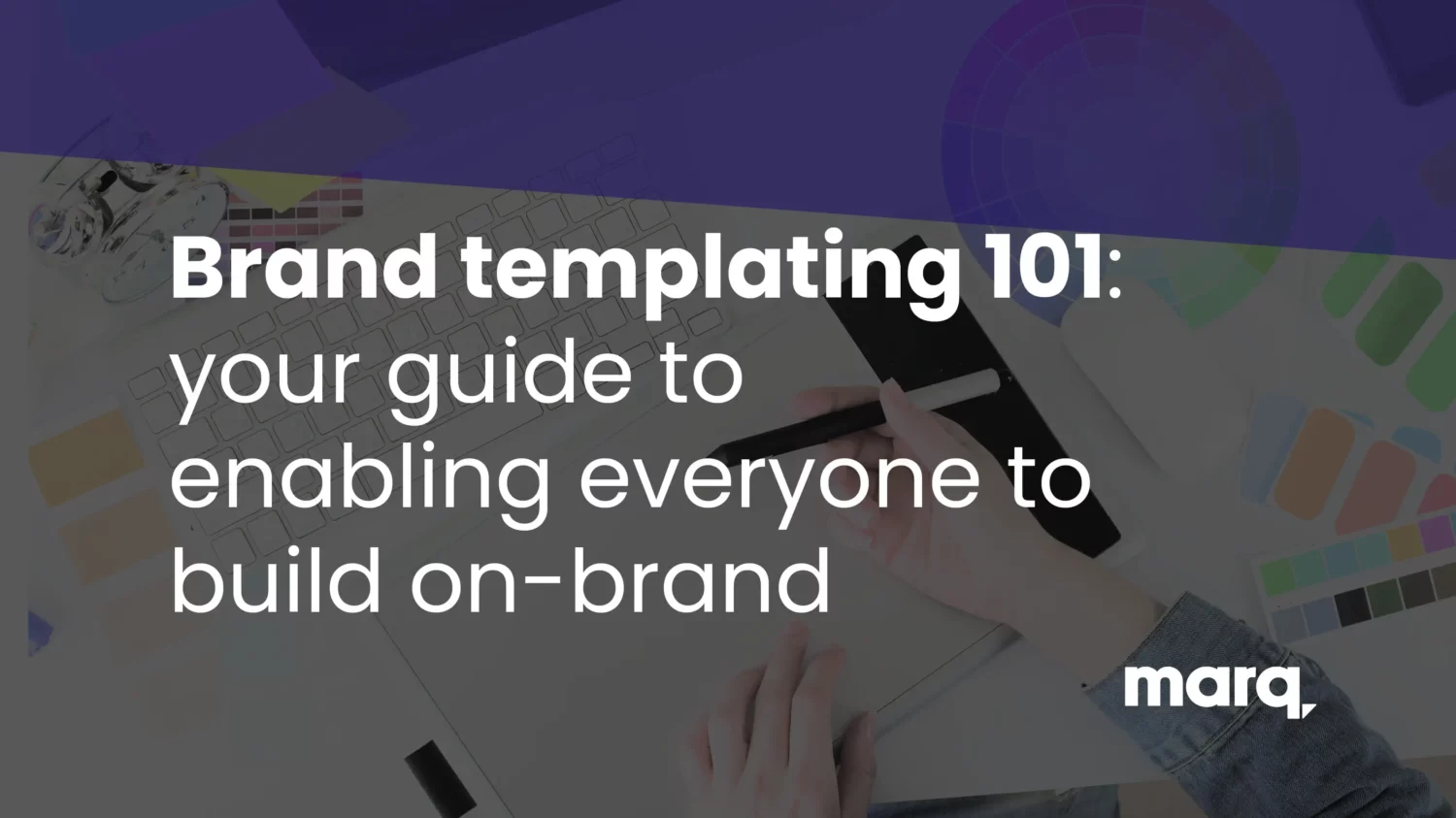Marketing and brand leaders everywhere obsess over the question: how can I most effectively manage my brand? Yet, most brand management solutions fail to provide business leaders with the answer to that question.
Why? Because they don’t utilize the most precious resource, a company has to offer: its people.
In this article, we’ll walk through how brand templating can help you more effectively manage your brand by enabling everyone in your business to build on-brand content.
Read on to learn:
- What is brand templating, and why should you do it
- How to build your brand template library
- The dos and don’ts of brand templating
- How to implement brand templating at your organization
In today’s world, effectively managing a brand means building brand equity that drives results:
- Increased brand awareness
- Increased customer engagement and loyalty
- Increased revenue
But it’s complicated.
The market is more crowded than ever, so your potential customers are bombarded daily with near-constant brand interactions.
With increasingly accessible consumer data, personalization has become the norm, and the brands that can’t personalize, quickly fall behind.
And resources are scarce, so keeping up with the volume of content needed to win in today’s marketplace feels near impossible when you can’t get approval to hire another designer.
How do you stand out when every company is a content creation company?
Are you content with your content?
The truth is that most organizations aren’t. Many marketing leaders say they believe personalized content could substantially increase their revenue, yet only 32% can do it. When put into practice, brand standards can be difficult to implement across organizations.
The more brutal truth is that your brand strategy is less effective if your organization cannot implement your brand effectively. In this article, you will learn how to carve out more time for content personalization and strategic projects sans unlimited resources and time travel.
While content operations vary by organization and industry, the numerous hurdles in the content creation and execution process seem to be universal:
- Marketing and Creative struggle to enable cross-functional teams to deliver branded assets without the burden falling largely on their shoulders.
- This is not only frustrating for them but also for the creative requesters who are trying to execute quickly.
Higher demand for content without a clear path to meet it contributes to a chaotic content operations process.
Brand Templating
How can you make content creation easier?
Brand accessibility and usability are characteristics of a mature brand strategy; they also empower teams to deliver on marketing initiatives easily. When creative teams develop a brand standard to implement cross-functionally, the organization can deliver on goals faster and more effectively.
If you’ve made it this far, you likely want to know how to do it. So, pour yourself a fresh cup and settle in.
Let’s start with the basics.
What is brand templating?
Understanding the HOW in meeting content demand
Brand templating is the modern approach to brand management that saves your team time by empowering everyone in the company with the tools they need to build on-brand.
By converting frequently used assets (fliers, postcard mailers, social posts, etc.) into a format your team can customize, content is delivered faster and more effectively. When you enable others to build content themselves, your organization is better positioned to deliver on strategic growth initiatives that move the needle forward.
Brand templating isn’t just for efficiency.
Imagine what your team can accomplish when you:
- Eliminate the need to create something “new” every time
- Reduce creative and design requests (clear the inbox clutter!)
- Give time back for strategic projects
- Increase your ability to personalize content
Think about it this way.
78% of consumers prefer getting to know a company through their content
McMurray/TMG
This begs the question, is your content effective? If tailoring your content for your specific audience would drive more revenue, then the incentive to change how you approach content creation should be a priority. Brand templating is one of the critical tools you can use to build more relevant content.
Take a moment to reflect on your current brand management strategy. Does it look and feel a little bit like this?

Rest assured, you are not alone. This state of content chaos isn’t indicative of failure either. It is, in fact, a prevalent problem. Due to the lack of modern tools, a clear path to weed through the bottleneck of requests isn’t easy, especially with the added pressure to meet content demand.
Making sense of the content chaos
Rather than submitting a creative request and then waiting for your designers to execute based on their list of priority projects, content requests can be built by the requester themselves. With access to a branded design built with their end-use in mind, they can take the time to personalize the messaging based on their objective.
Whether organizations have a design team of one or twenty, we’ve seen brand templating work as a mechanism to streamline the content creation process and ensure a more impactful experience for the end customer.
Personalization in content takes thoughtful consideration, and often, this step in content production is rushed or skipped in the interest of meeting content demand. We’ve heard the commonly used phrase, “something is better than nothing,” however, when you settle for this approach as it relates to your content, you are leaving money on the table for your business.
95% of buying decisions are directly influenced by content
CEB Global
When put into practice, brand templating means that Sally in Sales can customize a mailer to send to prospects she hopes to see at the next event she attends.
Alex, an all-star real estate agent, can now produce the marketing materials for their new listing without waiting for their brokerages’ marketing team to get back to them with the latest agency logo.
Teams can customize more generic audience messaging and tailor it more specifically to their chosen audience, while templates ensure the content they produce stays on brand.
If a more effective approach gives your creative team back the time they need to be more strategic, directly impacting your buyers’ decisions, the takeaway is to leave no stone unturned to optimize your content.
Brand templating is one of the primary ways to implement a smoother content operations process rooted in strategy.
How to create a brand template library
What templates are must-haves, and how do you determine what should be templatized?
You likely have a few templates kicking around your shared drive, but have you equipped your team with the right ones, and could you expand your library? Templates can and should extend beyond the classic Keynote/Powerpoint presentation. Delivering and iterating quickly on content indicates an effective brand management strategy.
Evaluate your brand assets and consider how templates could better enable your teams; you’ll likely find that your team has a better opportunity to personalize your content resulting in a more effective message.
The concept of templatizing brand assets to execute content operations and strengthen brand management systems sometimes feels too big for organizations large and small to take on. To combat the general “overwhelm” in putting brand templating into practice, use the structure below to determine which assets you should include in your template library.
What brand templates should you build for your business?
A few must-haves for your brand template library may help you think more about your organization’s needs. As simple as they seem, they will save your designers tons of time.
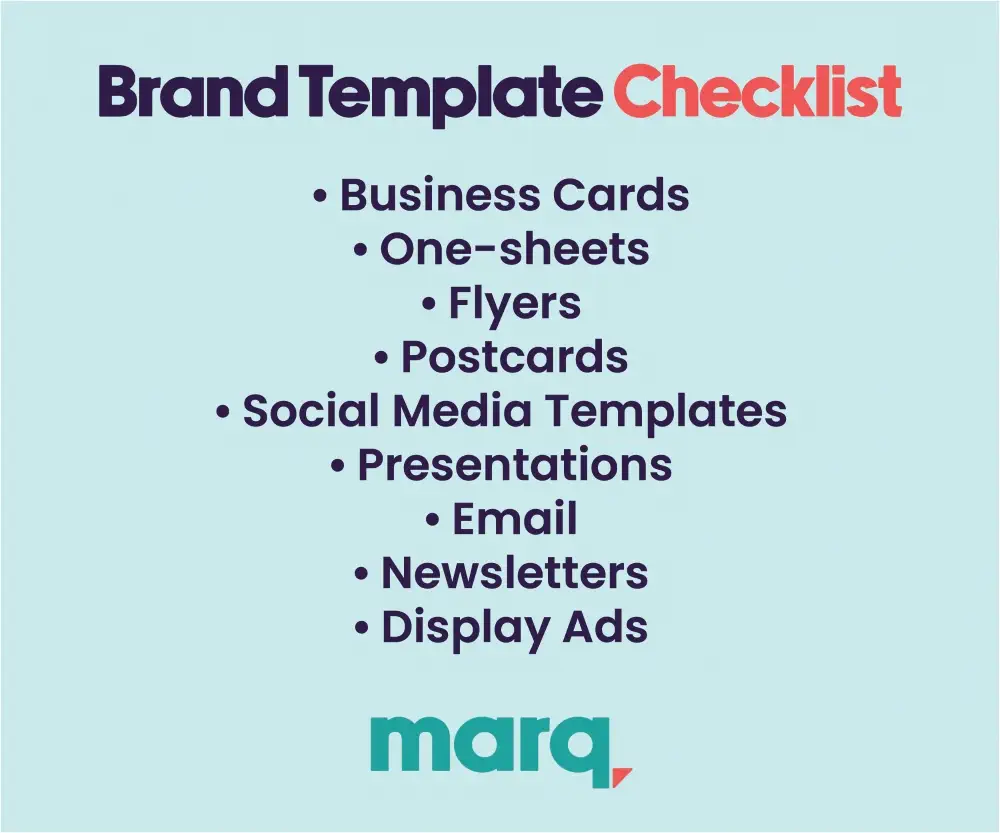
In addition to the base-level brand template checklist, you can assess what your organization needs in its template library by doing the following:
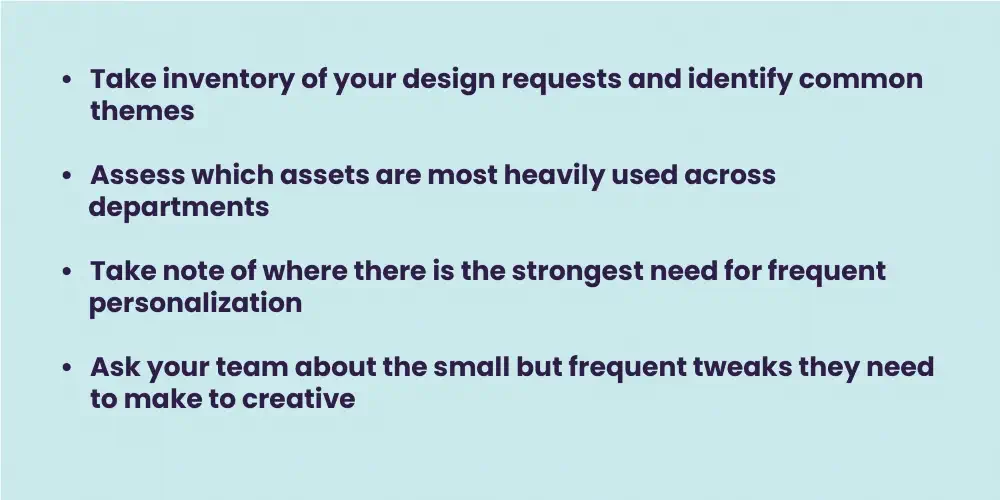
Because the end goal is to get brand teams to spend more time on strategic projects and less time on repeated design requests, ask yourself this critical question during the assessment:
Do these requests require creative strategy, or are they simple changes?
Here are a few examples of what we’d consider ‘simple’ changes:
- Personalization
- Scenario: Your industry one-sheet is for a general audience, and you want to personalize the copy, so it is better suited for a particular industry. This is a copy change that can utilize the same design and layout.
- Color change
- Scenario: You have five brand colors to choose from and want to change the primary color on your document headline from purple to grey. The integrity of the design is intact, and you’ve just changed the look of a standard document to keep things fresh. No need to funnel this type of request through design.
- Copy update
- Scenario: Your marketing team came up with a tagline, and you want to adjust your email template to include it. The creative of the email will stay the same; you just want to switch this simple line of copy.
While the templates your team utilizes may vary, the idea is to make it simpler for them to execute their requests. It can sound scary, but when customization happens within a specific set of parameters, it gives your brand team peace of mind while freeing up mental capacity for meaningful creative work.
Marq’s Creative Director, John Perry, noted that layout swaps would be a simple enough change for non-designers to execute.
“Newsletters and emails, for example, can be restructured by moving sections up and down in the template. It doesn’t require a designer’s touch, and content/email marketers can make these adjustments if they have a template to work from with customization parameters defined.”
You should equip your asset library with templates based on your findings and be sure to include a couple of options. With design variations of the same template, you are giving the power of choice to the creator and an opportunity for them to exercise creativity in how they customize their project.
Components of an effective brand template
What makes a template a template?
You are likely asking yourself how to outline a brand template with the rules you want your end user to follow. Much of the hesitation about enabling teams to create their own content is the uncertainty that they won’t follow brand guidelines or will take things a bit too far.
When creating a brand template, you want to be mindful of the components of a brand template to ensure that it is usable by your team once distributed. This means that the guidelines need to be clear. You decide the parameters for users to design within and you will find more success in brand templating if there isn’t wiggle room for questions.

Differences in the degrees of customization of your templates will always be based on the end user. These may vary by department/team and type of collateral, so the standards will likely change when you think put the users’ needs first.
For example, your marketing team may be given more design flexibility when they customize content for a specific campaign. But, you likely do not want that same level of flexibility given to someone in Sales or Finance.
Perhaps you have compliance-related standards that must be implemented; those types of elements need to be outlined so they are not changed and the user knows they are required.
Typical components of a brand template include:
- Logo / Mark / Branding
- Defined areas for personalization
- Supplemental required copy/design elements (Ex. Legal copy, specific taglines, etc.)
1. Logo / Mark / Branding
Brand consistency is paramount to the success of your content. The ages-old marketing “Rule of 7” is a bit dated considering the abundance of content that an individual consumes, but if you expect your audience to recognize your brand, it better be consistent every single time.
The consistency in brand builds awareness and creates trust. So, it can be concluded that the saturation of content across all channels requires a level of consistency in order for the audience to not only see your content but know it is coming from the same source.
Whether potential customers need to see your content seven or seventy times, a consistent brand image is critical.
2. Defined areas for personalization
We’ve referenced ‘personalization’ a few times now and we recognize this can have different meanings depending on the use case, industries your organization plays in, and whether you offer B2B or B2C solutions. We’ve also already talked about how valuable personalization is in driving revenue. But, we haven’t covered examples of when personalization is done to demonstrate content effectiveness.
When personalization is most effective:
One-sheets are a classic example of when you can change copy so messaging and terms within the document resonate with your target audience. Rather than speaking generically about your product solution, you can incorporate the exact use case for the industry. You can include language specifically for decision-makers.
The template solution for these allows product marketers to evolve their strategy on this particular piece of content on an ongoing basis. Perhaps a team from sales just got back from an industry-specific event, and their insight influences change on the document you’ve been using.
Rather than send that request to the design team to change, it can be executed immediately. These copy adjustments do not impact the overall design and your content is now updated strategically for your audience. NICE WORK!
If you are in real estate, brand templates allow marketing materials to represent the agents’ brand and your brokerages’ brand, with brand assets ready to go for agent customization. Agents can plug in their brand and their listing information, and rather than spinning wheels on either creating the content themselves (yikes!) or waiting for marketing to get them what they need, they are off to the races! Quite frankly, a necessity in this ever-so-competitive market.
Universities can ensure that across campus, colleges, departments, groups, and events maintain the same branding, with room for personalization for their specific audience.

3. Supplemental required copy/design elements (Ex. Legal copy, specific taglines, etc.)
For certain pieces of content, you may have multiple areas for customization, each of which could have a different purpose. There can be a primary copy area for personalization and additional places in the document’s footer that also need to be touched.
Examples include legal copy, specific taglines, or contact information. These areas will likely also require strict guidelines regarding font type and size so they work with the overall design. You can incorporate a standardized version of this into the template, but if that is not possible, you will want to clearly define these components within your template.
We often hear from financial services and banking that legal language is included in their content, but it can vary from mortgage lending to retirement services. These are considerations that are important to take into account.
While we covered a template’s “copy only” personalization component, some exceptions are worth mentioning as you are thinking through how to build the most effective brand template library.
For some organizations, specific business areas use different logos or graphics. Ideally, you create a template for every use case, but in some cases, you may need to allow the user to input that element. If that is the case, outlining where variation will live on the template, defining the appropriate size, and outlining the clear space requirements are critical.
We already talked about brand consistency in content; when we consider the larger brand guidelines and think about how they come through when implemented, it can sometimes challenge the guidelines. Those unique scenarios when a designer is faced with a new piece of content and has to think through how the brand will come through are why we stress the importance of building your brand template library with intention.
The best part? You can always change and add to your brand templates as new uses come up. This brings us to our next tip.

Ask the template users if what you have provided works for their needs. Perhaps new requests arise, and you decide as a team that a template would be helpful. That’s great! This is an ever-growing library that should support your organization’s growth goals.
That said, just like your closet, you should also run template audits to ensure the best templates are available and out-of-date templates get removed. You should never expect the end-user to know which templates are the most current, so managing that brand template library will keep everyone on track and building with the most current designs.
When brand templates aren’t the solution
The answer is not simple.
Now, this can get a little fuzzy, and first and foremost, this should be an ongoing discussion within your organization. Not every piece of collateral requires a template.
Here is why:
Brand templates give your team time for strategic work, but it’s important to know which projects should not rely on a template and which ones deserve additional resources. It is a balancing act because, in many ways, isn’t every project important?
Yes, it is. But, when put up against your brand strategy and growth initiatives, it would not be possible to put all of your resources towards every piece of content. That is how we got into the content chaos, to begin with, is it not?
Consider this…
If your team is given beautifully branded templates, is your content, after personalization, likely to be fairly successful?
And, how successful would it need to be in order for you to decide that your team is down the right path?
We have debated and pondered the idea of creative KPI’s and quite frankly, there are endless variables that can be used as markers of success. That said, every piece of content will have different success measures, whether those be related to clicks, conversion, referrals, or demos.
And so, we ask, how do we know that we are using our resources on the right things, and is the content that is produced via template serving the intent?
The simple approach is to think through projects and elevate opportunities where you can be more strategic to ensure a more successful outcome. As you consider design requests, always look for opportunities to level up your creative execution. Sometimes this means using a template; other times, it will require a more thoughtful implementation to ensure it delivers on the objectives of the project.

Just because your team has been given templates, doesn’t mean they don’t talk to your marketing and design teams about what they create. The difference is that now, not every project will require the time it takes to build ‘new’ creative.
This means, you can involve various members of your team to provide input, and the time can be spent on strategic messaging and positioning. Even better, marketing and design teams can focus on exercising their creative muscles to build new and exciting assets for your organization to leverage.
Each stakeholder is now working in tandem and in a better position in regard to time and energy, to ensure the content that you are creating is relevant and impactful.
Brand Templating tools and solutions
Support your template-based brand management
We just covered why brand templating can be a game changer for your business and we talked about building the right templates for the teams that need them. What we have yet to cover is how to share this library of valuable brand templates with your teams so they can use them.
There are a few solutions for effectively building and sharing your brand templates, ranging from a full-service brand-templating solution like Marq to more manual procedures. We run through the pros and cons of these various solutions together.
Ultimately, you will want to look for solutions that will provide your team with the ability to make edits to the templates. If the solution you have chosen does not have the ability to lockdown specific elements, you will need to indicate which areas of the template are theirs to customize and operate with a certain level of trust. It can be done but requires clearer guidelines for users. Your content operations workflow may already include a process for edits and approvals; if so, you will want to implement a similar one for templates so the right eyes are on the finished product before you print, publish, and distribute.
Below are options to consider if you are looking for a system or tool that will work with your brand templates:
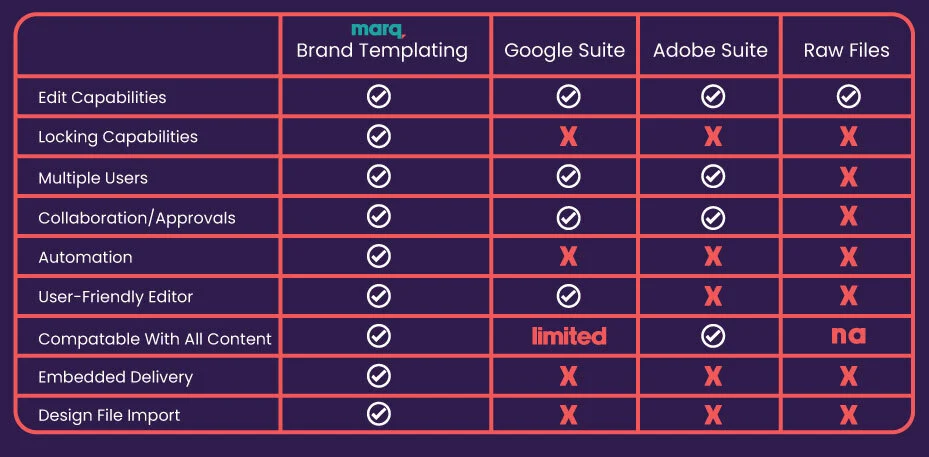
You may notice that file formats differ across various solutions and those tie directly back to edit capabilities. Unfortunately, determining the right file format for your branded templates that will allow for customization is often the hang-up on implementing brand templates.
Keynotes and powerpoints are so often relied upon by organizations and while they may start as a well-intentioned template, it is not possible to lock areas of the template. How many times have you seen a keynote presentation go south? The answer is too many. Keynotes and powerpoints have a high level of risk of off-branded or unpolished content making its way into the wild. We don’t like it and you probably don’t like it either.
Now, if you go with a fully lockable solution like a PDF, then the templates become unusable. Yes, there are ways to edit a PDF, but it doesn’t have the flexibility that you need in order for those templates to be truly effective. PDFs will limit the ability for customization significantly.
If you share design files then the expectation is that everyone is a designer. That isn’t feasible or advisable. Let designers be designers. Let everyone else execute on their specific talents. Your organization will be stronger when everyone is operating within their unique strengths.
The truth is of it is that there simply wasn’t a solution that solved all of the content operations challenges. In order to be strategic with your content, it has to be easier!
Meet Marq: The Brand-Templating Platform
Press play on some dreamy background music and let’s dive into Marq.
In a few words, Marq is the brand-templating platform that enables you to deliver relevant content to your audience, faster by empowering everyone in your organization to build on-brand content.
Marq takes all of the half solutions from above and combines them into one power-packed platform that does it all. Marq is made for designers to enable non-designers, so the two groups can work synergistically. We realize the word synergy is overused these days, but in this case, we mean it.
How does Marq work?
With Marq, you can import your brand identity and assets, which allows you to build templates and customize them in-platform. You can also convert existing assets, like your InDesign files, to brand templates and connect custom data to automate content creation.
We mentioned the issue with fully editable templates earlier and discussed why locked-down file formats make templates unusable. Marq keeps things in a happy middle ground so brand templates truly change the content game.
The built-in editor allows administrative-level users to implement varying degrees of locking depending on the template component. Logos for example can be fully locked so they can’t be stretched or moved to another location in the template. Areas for copy can have font and sizing parameters so users can’t enlarge text or change the look of the design. With template-locking enabled, the fear of letting anyone and everyone within your organization build content is a non-issue. You can allow teams to build the content they need with confidence and truly feel that your brand is always the star.
Do I need to store my brand templates somewhere and bring them into Marq each time?
No chance. Marq also stores your brand templates and you can share specific templates with certain teams so they can easily find the templates that apply to their job role and function.
The question of where you put all of these branded assets and the burden of thinking through an organizational system and structure that makes assets easy to find is in the hands of Marq. Users can log in, quickly find what they need, apply relevant customization within brand guidelines, and distribute content across channels.
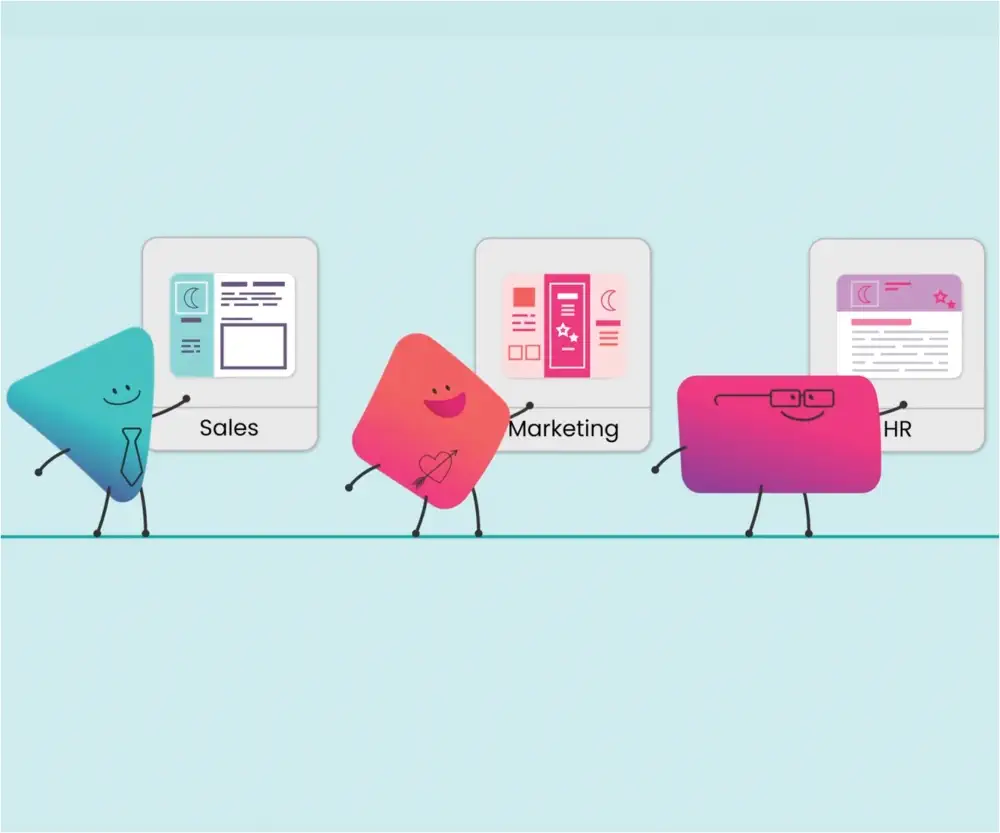
Outcomes of brand-templating platform bliss
Now, it would be unfair to say that brand templating can’t work for your organization without Marq. We just know, through talking with customers, how much easier it is when our platform is doing the work for them.
When brand templating is integrated into how you do business, you can take your content game even further. Content at scale is a standard Tuesday. You can implement automation so content creation is even more efficient. Your design teams suddenly don’t feel overwhelmed by production design work and their creative energy is flowing! Creative burnout? Never heard of it.

All of these positive outcomes are a result of a more strategic approach to managing your brand. Maturing your brand strategy through the use of brand templating has given your brand the ability to deliver more impactful content to your audience. Your organization can now easily manage content operations and your output has elevated your brand.
Here is the best part.
Your business wins.
- Brand templating has saved your team precious time.
- You’ve reduced risk by inputting crucial copy and design elements.
- Your content is compliant.
- Your content is personalized.
- You can meet content demand and deliver to your audience faster!
- You’ve ensured that when your target audience sees your content, they also see your brand, recognize it, and respond.
Now that’s magic! Want to learn more about brand templating or how Marq can help your business? Let’s talk.
Schedule a demo here or email us at sales@marq.com

